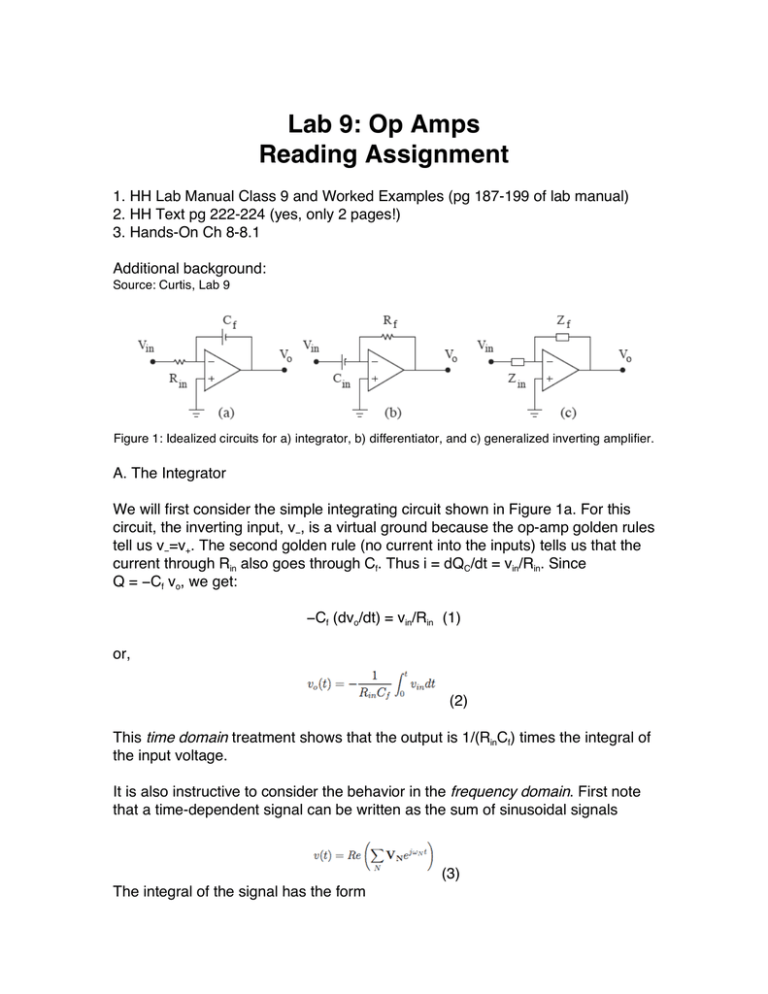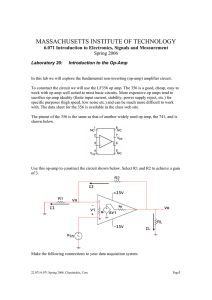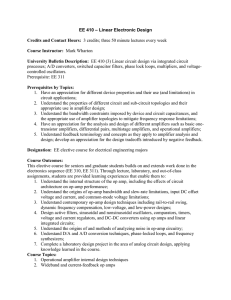Lab 9: Op Amps Reading Assignment
advertisement

Lab 9: Op Amps Reading Assignment 1. HH Lab Manual Class 9 and Worked Examples (pg 187-199 of lab manual) 2. HH Text pg 222-224 (yes, only 2 pages!) 3. Hands-On Ch 8-8.1 Additional background: Source: Curtis, Lab 9 Figure 1: Idealized circuits for a) integrator, b) differentiator, and c) generalized inverting amplifier. A. The Integrator We will first consider the simple integrating circuit shown in Figure 1a. For this circuit, the inverting input, v−, is a virtual ground because the op-amp golden rules tell us v−=v+. The second golden rule (no current into the inputs) tells us that the current through Rin also goes through Cf. Thus i = dQC/dt = vin/Rin. Since Q = −Cf vo, we get: −Cf (dvo/dt) = vin/Rin (1) or, (2) This time domain treatment shows that the output is 1/(RinCf) times the integral of the input voltage. It is also instructive to consider the behavior in the frequency domain. First note that a time-dependent signal can be written as the sum of sinusoidal signals (3) The integral of the signal has the form (4) Thus, to form the integral of a general waveform, we need a magnitude response that scales as 1/ω and that has a 90◦ phase shift over the relevant frequency range. Since the gain of the generalized inverting amplifier (shown in Figure 1c) is G = −Zf / Zin (5) the gain of the circuit shown in Figure 1a is just −(jωRinCf)−1, so we see that each term is weighted by the (jωN)−1 factor required in (4) to give the Fourier components of the integral. This again shows that the output is proportional to the integral of the input with the same −1/(RinCf) proportionality factor as above. B. The Differentiator The gain of the circuit shown in Figure 1b is G(ω) = −Zf / Zin = −jωRfCin (6) Using (3), (7) so to take the derivative, we need to multiply each Fourier coefficient by its frequency, ω, and introduce a 90◦ phase shift. The factor of jω in (6) shows that the circuit does exactly that. Thus the circuit in Fig. 1b is a differentiator. You may wish to prove to yourself that a time-domain treatment of the circuit gives the same results. C. Complications In practice, both these idealized circuits suffer from a similar problem. For the integrator, we must realize that the input signal is likely to have a small DC offset. Even a very small DC current will charge up the capacitor and cause the op-amp to reach its maximum output voltage within a short time period. For a frequency domain treatment of this problem, remember the gain of the integrator is (jωRC)−1. Thus, any non-zero DC input (which corresponds to ω = 0) will have infinite gain for an idealized op-amp. In reality, this means the op-amp output will reach its maximum voltage very quickly. A practical op-amp integrator circuit must be modified to keep the gain finite at low frequencies. Similarly, the idealized differentiator has a gain of jωRC that becomes large at high frequencies. This is both very difficult to achieve and makes the circuit subject to high frequency noise. A practical circuit will cut off the divergence of the gain at large so that the output is not dominated by high frequency noise. The op-amp open-loop gain, A(ω), will eventually reduce the gain at high frequencies. This implies that there is a peak in the gain somewhat like that in a resonant circuit. The circuits you build in the following sections will demonstrate, at least to some extent, how to cope with these problems.








